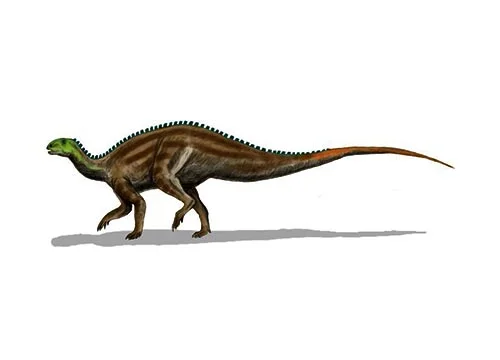Tenontosaurus (Sinew lizard)

Te-non-to-sore-us
John Ostrom - 1970
Herbivore
Estimated 5-7 meters long
Euornithopod
T. tiletti (type), T.dossi
Canada, USA
Early Cretaceous, 112-98 million years ago
Tenontosaurus Facts
Tenontosaurus, also known as the “sinew lizard,” is a genus of ornithopod dinosaur that lived during the Early Cretaceous period, around 112-98 million years ago. Its fossils have been found in what is now modern-day North America.
Tenontosaurus was a medium-sized herbivorous dinosaur, measuring around 16-23 feet (5-7 meters) in length and weighing around 1-2 tons. It had a long, stiff tail that it likely used for balance and stability while running, and long, powerful hindlimbs that suggest it was a fast and agile runner.
The name Tenontosaurus means “sinew lizard” in reference to the tough, fibrous tendons that were preserved in some of its fossils. These tendons may have been used to provide additional support to the joints of the legs and tail, allowing Tenontosaurus to move with greater speed and efficiency.
One of the most distinctive features of Tenontosaurus is its dental battery, a unique arrangement of tightly-packed teeth in its lower jaw that it likely used for grinding up tough plant material. This dental adaptation is seen in many other ornithopod dinosaurs, and it likely allowed them to exploit a wide variety of plant foods.
Tenontosaurus was likely preyed upon by large predators like theropod dinosaurs, and its fossils have been found alongside those of the early tyrannosaurid Dilong. However, its fast and agile nature may have allowed it to evade predators in the open forests and grasslands where it lived.
The discovery of Tenontosaurus fossils has provided important insights into the evolution and ecology of ornithopod dinosaurs during the Early Cretaceous period in North America. It was one of the most common herbivorous dinosaurs of its time, and its fossils have been found in a wide variety of environments, from forests to floodplains to dry uplands.
In conclusion, Tenontosaurus is an important ornithopod dinosaur from North America that lived during the Early Cretaceous period. Its unique dental adaptation and preserved tendons provide valuable insights into its anatomy and ecology, and its fast and agile nature likely allowed it to evade predators. The discovery of Tenontosaurus fossils has contributed to our understanding of the diversity and evolution of herbivorous dinosaurs during this time period.



